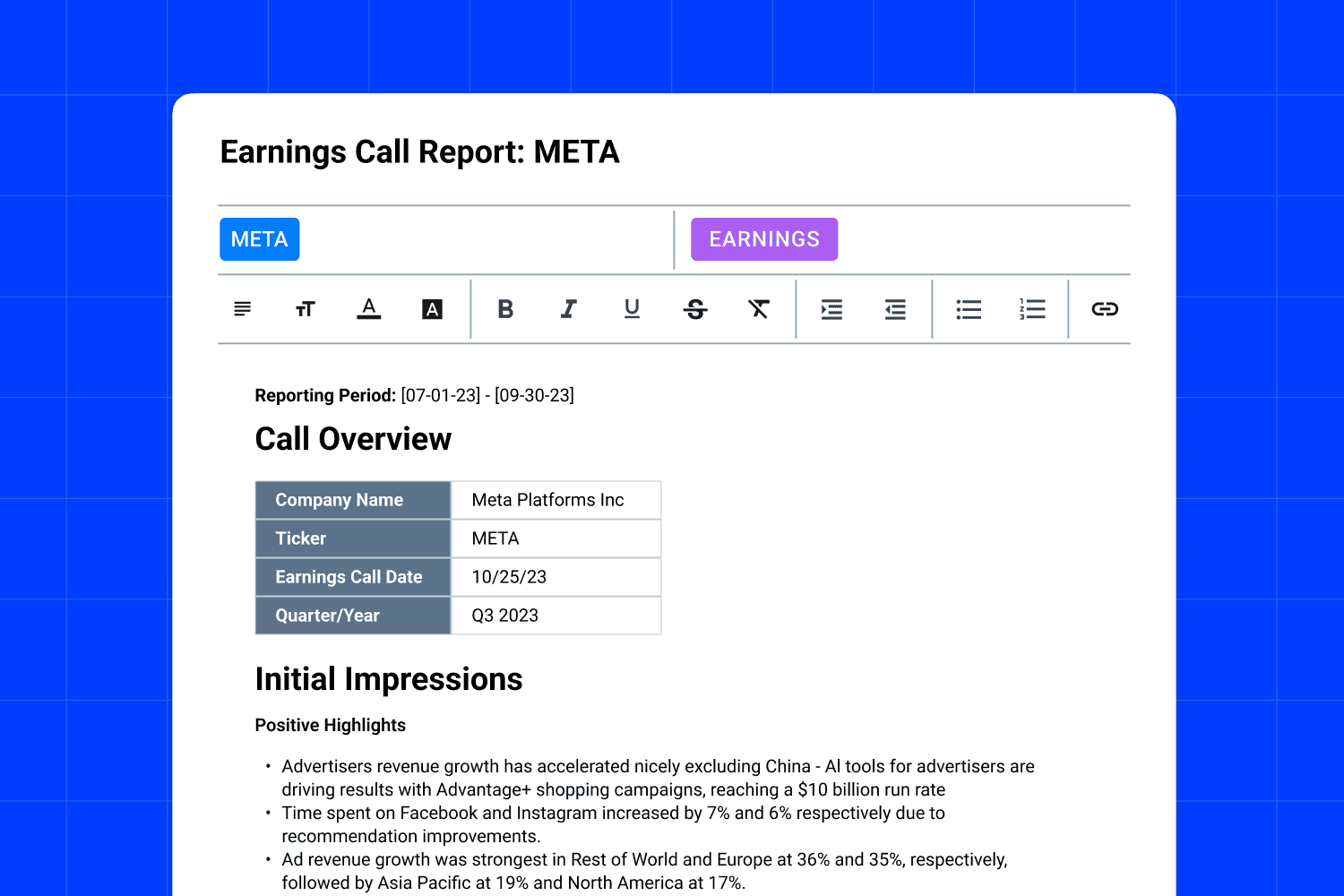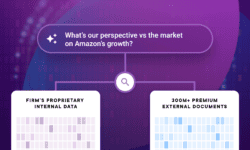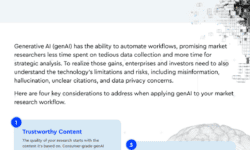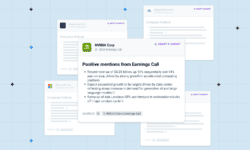As a Product Marketer, I know the research I conduct is only as valuable as the relative impact it has on the teams making strategic business, sales, and product development decisions everyday. Surfacing market, industry, and competitive trends is an important step, but a useless one if their delivery to relevant internal stakeholders is inefficient. This is why we’ve spent so much time developing a Notebook product that seamlessly integrates into our existing market-leading research and analysis tools. Ultimately, the research you conduct within AlphaSense doesn’t have to stop at discovery.
Today, we’re sharing five templates you can use in AlphaSense’s Notebook to streamline the process of creating your competitive intelligence deliverables.
1. Earnings Call Report
Earnings season is a critical time for accessing key information not only about company performance, but also corporate leadership guidance, micro-level business performance analysis, and the questions analysts are pressing C-suite execs to answer.
Earnings call reports give an overview of the fiscal performance for a company, based primarily on the content of an earnings call, with additional color added via analyst commentary. By consolidating this key information for those who do not listen to competitor or peer earnings calls regularly, your team and organization can stay informed on the market trends and competitive movements that influence corporate strategy.
The content of these reports is entirely dependent on the needs of the business, but typically include info regarding:
- The Basics: stock performance, revenue, EBITDA, EPS, cash flow, etc
- Performance (both positive and negative, answering questions like “what are general positive/negative outcomes or signals from the quarter?”)
- Outlook/Guidance: company expectations for upcoming quarters/fiscal year
- Financial & Operational highlights: What was the actual financial performance, what business lines are performing well, and which are underperforming?
- Market Reaction: How did analysts respond to the call? Did they upgrade/downgrade/etc? What performance signals did they point to?
- Follow-Up Actions: How this impacts your teams and what they can work off of for future activities
2. SWOT Analysis
SWOT (strengths, weaknesses, opportunities, and threats) is a common strategic analysis and planning framework that assesses the relative position of a business within the market overall—and specifically a company’s competitors. Focusing on defining these four elements for areas of your business, a competitor, or a client allows you to develop a fact-based analysis that provides heightened clarity around not just your current position in the market, but also which future strategic investments have the potential to help you take the lead.
If we’re creating a competitive SWOT analysis, some of the factors to consider within this matrix include:
- Brand Recognition
- Cash Flow/Financing
- Financial Performance (including Earnings Reporting, if public)
- Technological Innovation (or lack thereof)
- Market Penetration
- Employee Retention/Satisfaction
- Strategic Investments (including M&A activity) & Partnerships
- Relevant Regulatory Changes
- Competitive Landscape
3. Battlecard
The teams that are selling and those that are conducting competitive research are typically not synonymous, and certainly not at large organizations. At the same time, understanding how to effectively position your offering against competitors is one of the most critical components of the sales process.
Battlecards are an efficient way for competitive intelligence, product marketing, and sales enablement teams to translate the swaths of competitive research happening within an organization into actionable insights for sellers.
An exemplary battlecard not only compares products and services, but focuses on key competitive advantages and value propositions that position a business’s product well against competitive offerings.
The information included on battlecards is highly dependent on the needs of sellers, but typically shares:
- An overview of a competitor’s products/services
- Pricing information
- Side-by-side feature comparisons
- A competitor’s relative strengths/weaknesses
- Our differentiators
- Why customers have chosen us (including quotes if you have them!)
4. Company/Competitive Intelligence Newsletter
A Company Newsletter can take many forms. In this case, we’re talking specifically about an internal newsletter distributed across teams to keep them informed about relevant market, industry, and competitive insights that can impact the strategic decisions they’re making day-to-day.
While this type of newsletter could be produced by competitive intelligence, corporate strategy, sales enablement, or product marketing teams, what they have in common is their impact on selling conversations, marketing and product decisions, and strategic shifts—from ICs to C-suite.
New industry players emerge, competitors shift strategies, and nascent technologies explode onto the scene (i.e. genAI and ChatGPT). Company newsletters can help eliminate intelligence silos and keep an entire organization abreast of key updates and aligned on business, messaging, and selling strategies.
As such, these newsletters typically include information regarding:
- Industry news and trending topics
- Competitor news (i.e. financial reporting, new partnerships, mergers & acquisitions, and product announcements)
- Upcoming events, webinars, and conferences
- Industry thought leadership pieces
- Insights from customers/prospects
5. Market Trends Analysis
A Market Trends Analysis allows you to evaluate evolving trends within a specific market or industry, along with competitive signals and priorities. Researching and monitoring these trends allows you to identify new opportunities, make more informed (and proactive) business decisions, and stay ahead of the competition.
From B2C to B2B to B2G, this could include anything from tracking consumer trends and spending patterns, to monitoring emerging technology or areas of investment, to staying on top of new regulations, bills, and budget decisions.
No matter the market you’re reviewing, the information in this analysis will likely include at least some of the following:
- A statement of market definition (scope, components, boundaries, TAM, etc)
- Emerging trends, including technological innovation, shifts in consumer behavior, and/or legal/regulatory changes
- Areas of market growth and decline
- An overview of the competitive landscape
- Economic influences (i.e. macroeconomic factors, supply chain, etc.)
- Forecast and predictions
- Recommended actions for the business to pursue
But Deliverables are Nothing Without the Right Information
Just as insights are only as valuable as they are actionable, deliverables are only as valuable as the insights they contain. As it becomes more difficult to stay on top of market intel, AlphaSense is here to help you filter through the noise faster and produce more comprehensive analyses to ensure your colleagues have the right information, at the right time, to make market-moving decisions and outpace the competition. With our platform, you can access key market data within earnings calls, global filings, broker research, expert interviews, news, trade journals, and more to deliver impactful research across your organization.
Ready to take your competitive intelligence to the next level? Start your free trial of AlphaSense today.









